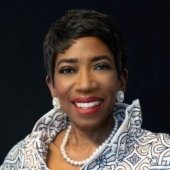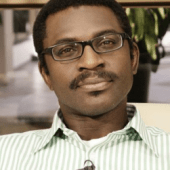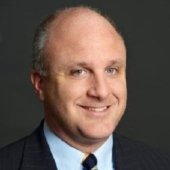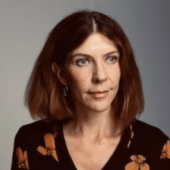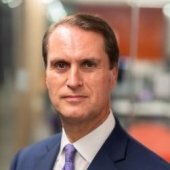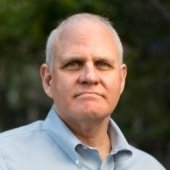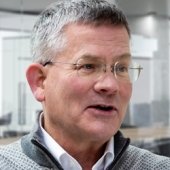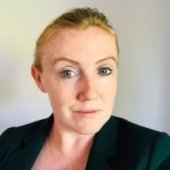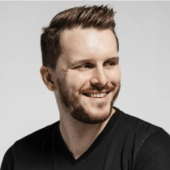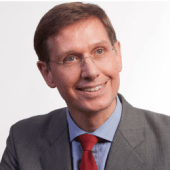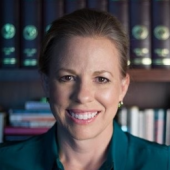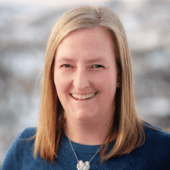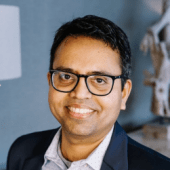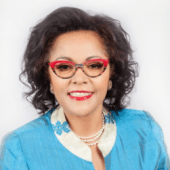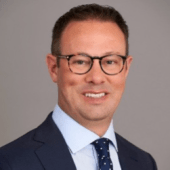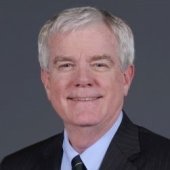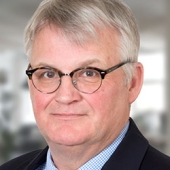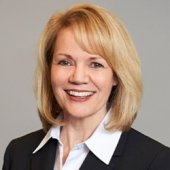IN BRIEF
- 9:15 - But it’s like anything else, there’s a pendulum swing. We’re seeing a huge focus on ESG, and now we’re seeing some pushback on that, on doing good, and what that means, and what does that mean from an investing perspective, and should these portfolios focus on doing good or should they focus on profit? I think you can focus on both.
- 17:01 - We say that businesses should be hiring these women because it’s the right thing to do, but the reality is they should hire them because it’s going to benefit their businesses. They bring a nontraditional skill set into the workplace, and they bring a sense of resilience and tenacity that you’re not necessarily going to find in your traditional employees. They know how to think on their feet, they know how to overcome, they know how to make things happen, they’ve been doing it their whole life.
- 30:05 - What I think is really significant is we’re going to see a lot of families that are living different lives in 10 to 15 years because of the businesses that implement these principles. My children were born into the welfare system; but because I was given an opportunity, they did not grow up in poverty. Those two kids now have children of their own, and none of my grandchildren were born into poverty. Whew!
In this VISION by Protiviti podcast, Protiviti’s Amber Acosta, Manager with the Diversity, Equity and Inclusion team, speaks with Dr. Shannon Deer, Interim Associate Dean for Undergraduate Programs at Texas A&M’s Mays Business School, and Cheryl Miller, founder of Quantum Consulting and Training, which helps women who have experienced hardships find meaningful business careers. Deer, whose work focuses on corporate social responsibility and the intersection of business and social challenges, and Miller are co-authors of “Business Doing Good: Engaging Women and Elevating Communities,” which outlines six principles business leaders can implement to effectively hire women who have experienced serious hardships—incarceration, poverty, homelessness, addiction, violence, or engagement in the sex trade—to positively impact lives, businesses and communities.
Dr. Shannon Deer, Ph.D., CPA, is the interim associate dean for undergraduate programs for Mays Business School at Texas A&M University. She is an award-winning professor who prepares experienced professionals in Texas A&M’s MBA and other master’s programs for successful careers in business. She also conducts executive development training for leading companies. Shannon’s research focuses on women’s transition experience after exiting the sex trade or sex trafficking situations. Co-author of “Business Doing Good: Engaging Women and Elevating Communities.”
Cheryl Miller owns Quantum Circles Consulting and Training, which focuses on transformation in several areas: nonprofit leadership and capacity building, economic development for the marginalized, effective communication focusing on the facilitation of conflict, and restorative justice. Previously, she was the Executive Director of a nonprofit housing program for women seeking to move from poverty, addiction and homelessness to healthy independence. Co-author of “Business Doing Good: Engaging Women and Elevating Communities.”
J. Amber Acosta serves as a Manager on the Diversity, Equity and Inclusion team at Protiviti. Her charge is to fully integrate Protiviti’s value of inclusion to our overall business strategy by strengthening diversity; nurturing a culture of equity, inclusion and belonging; and expanding our impact. She is specifically charged with developing a gender equity strategy for Protiviti, including strengthening strategic partnerships, working alongside gender-based ENGs, and ensuring that the talent pipeline remains strong at every level.
Podcast transcript
Joe Kornik: Welcome to the VISION by Protiviti podcast. I’m Joe Kornik, Editor-in-Chief of VISION by Protiviti, our global content initiative examining the big themes that will impact the C-suite and executive boardrooms worldwide.
Today, we’re exploring the future of ESG and its strategic implications for 2030 and beyond, and I’m thrilled to be able to welcome two wonderful guests in, Dr. Shannon Deer and Cheryl Miller, co-authors of the book, “Business Doing Good: Engaging Women and Elevating Communities,” which outlines six principles business leaders can implement to effectively hire women who have experienced serious hardships: incarceration, poverty, homelessness, addiction, violence, or engagement in the sex trade.
Shannon is currently the Interim Associate Dean for Undergraduate Programs at Texas A&M’s Mays Business School and a clinical associate professor. Her work emphasizes the importance of corporate social responsibility, along with the intersection of business and solutions to social challenges, specifically ways businesses can invest in women to positively impact business and the communities in which they operate.
Cheryl Miller is a former teacher and an 18-year veteran in the nonprofit sector before she started her own business, Quantum Consulting and Training, which helps women who have experienced hardships find meaningful careers to help them transition back into society.
I’m thrilled to have them both on the podcast today, and I’m also happy to welcome in my Protiviti colleague, Amber Acosta, Manager on the Diversity, Equity and Inclusion team. She is specifically charged with developing gender equity strategy for Protiviti, including strengthening our strategic partnerships and ensuring our talent pipeline remains strong at every level.
Amber, thanks so much for doing this today, and I’ll turn it over to you to begin.
Amber Acosta: Thank you so much, Joe. Appreciate it. All right, welcome to you, Dr. Shannon Deer and Cheryl Miller. Excited to join here with you today. So, let’s go ahead and get started.
Shannon, I wanted to talk to both of you about the starting of your book—what an impactful book and a great space for you all to be with us today. Let’s hear a little bit more about the origin story of the book. How did you two get connected, and why did you decide to write this book?
Dr. Shannon Deer: Sure. Thanks, Amber. We’re excited to be here. Well, I was doing some research in 2016 on women who were exiting the sex trade and their experience, really, in how work, lawful work, really influenced their transition out of the sex trade. So, I had called a bunch of different organizations to help try to find participants for the study, and somebody said, “Well, if you really want to know someone who’s really helping women transition out of whatever challenge they’ve had, you should call Cheryl Miller.” So, I called her up, and the way I tell the story is that she grilled me a little bit to make sure that I was going to take good care of the women that I was interviewing, but she doesn’t remember it exactly the [Laughter] same way, so she thinks “grilling” is too strong of a phrase. But it was a great conversation and really talked about what some of her philosophies were.
When I went to interview the women that were—she was running a housing program for women who were overcoming poverty, addiction, incarceration, and there was a lot of intersection of women who had engaged in this sex trade. So, when I went to interview the women from her organization, I really saw a significant difference in the experience they had and the outcomes that they had compared to other organizations that were supporting women. So, I wanted to know what was different, and she was excited to get to see that from a research perspective.
So, I went and did that, and then we’ve stayed in touch over the years, and she wrote me an e-mail one day and said just, “Hey, do you want to write a book together?” I wrote back and said, “Yes,” and then instantly wrote back again and said, “Wait, what is this book about?” Assuming it was about the women that I had interviewed and kind of their experiences and what she had done, but I wanted to make sure. So, then she said, “Yes, it’s about that.”
So, we started writing. We actually wrote a version of the first few chapters and completely scrapped it and really redesigned it to be centered around the stories of women who have had these challenging experiences and overcome them and the support that they received that worked. So, the book has six principles, but it also has six stories that are not any one woman’s story necessarily, because we don’t want to tell those, we want them to be able to tell them, but it’s an intersection or a conglomeration of a lot of different women’s stories about their experiences.
So, I know Cheryl has her own experience with overcoming, and so I’d love for her to share that story, too, which had a great influence on the book.
Cheryl Miller: At that time, we were doing this work at the housing program that I was running and we were seeing such significant results, and I was thinking, “Gosh, I wish there was some way to let other people know about this.” So, when I reached out to Shannon about writing the book, I thought this is going to be a perfect partnership because what we were doing was hands-on, grassroots kind of work, but Shannon brings such a different perspective to it with her business background and her research, and so it was really exciting.
For myself, it was 30-something years ago that I was a single mom. I was pregnant and homeless, and I had two children that were born into the welfare system. Actually, when I was pregnant, I found out, when I went into labor, that I was having twins, and not only twins but they were now found out then that they were 10 weeks premature; they were only 30 weeks. So, I had two really sick babies that were born into the welfare system. And the people that worked with me after that were people that realized that I didn’t need to be fixed, I needed to be challenged, and they provided support for me to go back to school. So, I went back to school, got my degree, became a teacher, and then eventually left teaching and moved into the nonprofit sector.
When I first started working at the home, I realized that the women were just like the past me and that this was something that resonated with me, and I knew that it would work. I brought my perspective from my own personal experiences of I had what it took to make it, I had what it took to overcome, and so I knew that these women did, too. So, we just moved in that direction, and we just kept pushing forward, and we ended up creating a really powerful model, and that’s what the book is about.
Amber Acosta: That is really fantastic and thank you for sharing that with us. It is certainly valuable for us to hear those different perspectives.
Shannon, I remember fondly as you were doing that research and to these women overcomers, and then also tying that, I remember at the time, tying that to your business perspective. So, I think it’s really fascinating to hear Cheryl tell the story of how she wanted to understand how to scale, right? We say in business, how do you scale this concept of this model?
So, before we dive too deeply into it, I did want to take a step back and take a look from a macro level. I think the perspective that you both provide, Cheryl as an overcomer, and Shannon with your business acumen, that unique perspective and view into the world, in general, how do you think business leaders are doing right now in terms of “doing good,” right? Title of the book, “Business Doing Good,” how are we making choices, and are we making the right choices in the diversity, equity and inclusion space? I know we talk a lot about business ethics as well, so how optimistic are you that we’re heading in the right direction and will ultimately make good choices?
Dr. Shannon Deer: None of it’s easy. So, are people doing a great job? I think we’re on the right trajectory in a lot of ways. It’s been an interesting evolution to see ESG, which has a big diversity, equity and inclusion component as part of it, and doing the right thing, it’s been interesting to see over the years how this has evolved.
I was talking about these things several decades ago, and no one was listening. [Laughter] I was part of helping some companies do their very first sustainability report, some large companies to do their very first sustainability reports. It was interesting because I have an accounting background and worked in public accounting, and so there was some aspect of that that had—and we’re seeing it even more now—but some aspect of that where the reporting side of it, we’re doing the 10-K and so, hey, how do we do the sustainability report annually in the same way that we’re doing the 10-K? So, I was excited about it from that perspective and really seeing companies make some better decisions and try to find strategic ways to not only improve in doing good but improve their profit as well.
So, I was kind of beating on the doors and really excited about it, and it was not getting a lot of traction 20 years ago. But now, it is; people are really paying attention. I think we’re at a really interesting inflection point or pivot point or whatever it is right now where if things continue on this trajectory, we could see some really good things. And if they don’t, I’ll be really disappointed, and where we go.
But it’s like anything else, there’s a pendulum swing. We’re seeing a huge focus on ESG, and now we’re seeing some pushback on that, on doing good, and what that means, and what does that mean from an investing perspective, and should these portfolios focus on doing good or should they focus on profit? I think you can focus on both. I think that there’s a way both in investing and in a company.
So, I’ve seen companies do ESG well from a strategic perspective. I have seen a lot of companies not necessarily not do it well but not do it from a strategic perspective. So, there’s a big difference between philanthropy and ESG. They’re both great, and companies have—there’s a place for both in companies, but they’re different.
So, really, what I’ve tried to do with companies is say, “Okay, I want you to do this because it’s the right thing. I do. I want you to do diversity, equity and inclusion because it’s the right thing.” But I can also make a business case for it and here’s the business case for doing for doing all of these things within ESG strategically.
When I see a lot of the pushback on ESG, I start to ask questions like, do you think it’s a bad thing if companies can remove human rights violations from their supply chain and make a profit in doing so? Is that a bad thing? Just answer those questions. I actually work a lot with oil and gas companies as well, and ESG, that’s been in the news a lot. Are oil and gas companies excluded from these ESG portfolios from an investment perspective? But I get to see these oil and gas companies be some of the leaders in ESG, and it’s been really interesting. Now, are they going to have lower emissions than Protiviti? No, [Laughter] but they are really trying to work towards the holistic view of ESG.
So, it’s challenging, it’s not going to happen overnight. If we stay on this trajectory of really improving in this area, I’m so optimistic. I’m also cautious because I’ve seen it get some momentum and then lose it, and get some momentum and lose it, but I’ve never seen the momentum like this around these topics, and I’m excited.
Amber Acosta: So much of what you’re sharing their ties to other work that we’re doing. So, I know I’m working more directly with our EVP of DEI and ESG here at Protiviti. A whole lot of letters to say! [Laughter] Someone that is helping to talk about the intersection of diversity, equity, inclusion and ESG as more than just the S in that model, but I think you so wonderfully laid out how it is taking this momentum and capitalizing on it.
I think we talk a lot in the DEI space about we’re getting past DEI as a moral imperative and instead looking at it more so as strategic business imperative and how does it infiltrate everything that we do here at a company-wide level? So, thank you for so wonderfully illustrating that, and I think you’ve really done a lot to help capture how this is the right moment for the challenges that are laid out in your book.
So, let’s turn back to the principles that are outlined there. As mentioned in the intro, the book highlights the six principles business leaders can implement to effectively hire women who have experienced serious hardships. You all call them “women overcomers.” As Cheryl mentioned and you talked about, you’ve used some real-life examples and how powerful that is to kind of take their stories and collate them into six narratives that were really able to follow the principles.
Cheryl, can you please take us through some of the highlights of these stories?
Cheryl Miller: It was really, it was only in the last probably a couple of years of working on this that we really started seeing a dramatic change. It was kind of like a snowball effect, where it took one or two women to really get in there and try it, and then we realized it started working.
One of the early stories that we tell was of a woman, she was the first one that we did a microloan for, and she launched this small business. It was kind of her side business and she was doing it very well and she was making money at it, and she was only seven months sober from a 21-year crack addiction and she was homeless and had been on crack for 21 years. She was only nine months sober when we lent her the initial money for her loan, which puts her at a really high risk [Laughter], obviously, but we had safety parameters in place to address the issue that might come up with having that kind of money and having a problem with addiction. But within a very short period of time, she had paid her loan back in full and she was never late on a payment.
She’s still in business today, and she is doing well. She ended up being a mentor to several other women that launched their businesses. At one point, she kind of hit this barrier. She found out that she was going to have to get some kind of federal approval, and she looked into it, and the paperwork was just absolutely overwhelming. So, she was like, “I can’t do this, I’m going to shut my business down,” and I was like, “Why in the world are you—why are you freaking out over this? You’ve overcome so many other things. What’s the deal with this one?” She said, “Well, I don’t want to do it because I’m afraid if I start that process and I do it wrong, I’ll fail and I’ll look like an idiot.” I looked at her, and I was like, “Are you serious? I mean, you’re afraid of failure?” I said, “You’ve been a failure your entire life.” [Laughter] It’s like, “You’ve overcome every single time, so why in the world would you be afraid of it now? If you fail, you fail. It’s not going to hurt anything.” She just looked at me and laughed. She said that’s not very nice, but she realized it was true, and she went on to complete all the paperwork and she got the certification that she needed.
So, to me, she’s just a really good example of how somebody who shouldn’t have the experience can figure out how to do something as complicated as federal regulations to be able to monitor their business and continue to grow, which is what she’s done over the years.
Amber Acosta: I really do love that story. I think it’s so much, so capitalizes on the principles that you all outline, and something that I really heard in there is you all were taking some risk, right? All of that is about taking a risk assessment and then weighing that out and taking a chance on her, as people would say. You said that she had been labeled as a failure her whole life and instead, to help her reframe and how she’s an overcomer, and I would just really love that.
I think so often, in corporate social responsibility or in ESG, it is daunting in that same way, right? That it’s a little bit of uncharted territory and it’s sometimes simpler for companies, as Shannon was mentioning earlier, those in oil and gas, to think of their carbon footprint or their emissions. I’m a little bit different for those of us in consulting to think about ESG.
I think there are some real correlations here, though, between—and I’m continuing to hear both in the stories and in the book overall—some obvious aspects of CSR and of ESG. But I want to pull this back to that point that we were talking about earlier, how it’s not just about doing the right thing or making a significant positive impact, but that there is a real strategic business case to be made here. Would you agree, Cheryl?
Cheryl Miller: Absolutely, absolutely. We say that businesses should be hiring these women because it’s the right thing to do, but the reality is they should hire them because it’s going to benefit their businesses. They bring a nontraditional skill set into the workplace, and they bring a sense of resilience and tenacity that you’re not necessarily going to find in your traditional employees. They know how to think on their feet, they know how to overcome, they know how to make things happen, they’ve been doing it their whole life. Unfortunately, most of them for the wrong reasons, but that skill set ends up being a really valuable asset to the workplace.
We tell the story of there was this one woman that I knew. She had been on heroin and crack for 20 years, and she lived in a metropolitan city at that time and she decided she needed some more dope and she didn’t have any money. So, she got on a bicycle in the middle of the summer, it was like in August. She rode down the feeder road to the freeway to a mall that was near where she lived, went in, shoplifted a bunch of jeans. Of course, they saw her, so they started chasing. They expected her to get in a car, but she ran around the back because she was on a bike. Got on the bike and ran to the backroads with the jeans and bags on her handlebars, took them and sold them, and used the money to buy drugs.
Now, obviously, we don’t want her doing that type of work, but how many employees, how many people would like somebody who would do that kind of—go to that kind of extreme, ride a bike for two hours to get the work done and then hustle to make it happen? All she had to do was translate that skill set into a workplace, and she becomes a really valuable employee. She’s no longer doing anything illegal; she’s now being an asset to the business and she’s increasing the profit for the business because she’s an incredible employee who works hard, who works fast, and is loyal.
Amber Acosta: I can certainly see that there. I think you have done a great job, both you and Shannon have done a great job of convincing business leaders that this is a good thing. So, I want to ask you, what’s next? How do we help business leaders put a plan into action, and what do they need to help guide these women overcomers throughout their career?
Dr. Shannon Deer: Yes, I’ll start that off. There are a few things that businesses can do. First of all, I will say, when we talk to companies, and we talk to a lot of companies about hiring overcomers, because, obviously, companies right now are struggling to find human capital and to find top talent. We have organizations that can be a pipeline to hiring really good employees that will be loyal and reduce turnover. We see all of these outcomes that are really important, and it’s in our research, but it’s also in other research that’s being done.
The Business Roundtable is doing some research with their Second Chance Coalition, and we’re seeing all kinds of really good things with—and we obviously look at a broader population. They’re looking specifically at people who’ve been formally incarcerated, but we’re seeing all kinds of good things, and we’re able to really talk to companies differently than we used to. We aren’t having to do quite so much convincing, one, because there’s a need to create a new pipeline of talent, but also because employers’ views are really changing on what it means to have a criminal record. So, we are seeing that. It needs to continue, and it needs to flow down through the organization.
So, some next steps that companies can think about is how can they really push that attitude down through organizations? The data’s showing us that we’ll still talk to companies sometimes and they’ll say, “Well, we’re willing to take a chance on these women,” and we’re like, “It’s really not a chance. The data shows that there’s not worse outcomes, there’s not higher firing rates.” In fact, a lot of the people that I talk to, I go into prisons and work with women; Cheryl goes into prisons and does some other work, but I get to work with women on helping them build their business plans, and they’re all like, “Well, I have this charge, is that going to prevent me from getting a job?” I’m like, “Not in most companies.” There is an opportunity in some companies to find those people who are willing to hire people who have a criminal record. We also know that in the U.S., there’s an equal number of people who have a college degree and those who have a criminal record. So, we’re starting to see that shift.
I’ll give a plug for Cheryl because she’s awesome and incredible, and she owns a training and consulting organization that helps companies really put these practices into place.
So, thinking about next steps, I would say if you’re an executive in an organization, read the book. That’s not just a shameless plug on the book. It’s just that we wrote it so that it was an easy way to get all the information we know. But read the book, and then reach out to Cheryl and talk to her about doing some trainings with your organization to really push that concept throughout the organization.
Cheryl, you have a great story about a company in your town that came to you because Cheryl was creating a pipeline for employers. Her housing program was developing talent in a way that other organizations weren’t. Even higher education wasn’t training talent in the same way, and she had lots of different training organizations, but one of the companies came to her and said, “We need more women like the women that are coming out of your organization. What can you do to help us get more people? What can you do to train people who aren’t going through your organization to get them ready in the same way that the women are?” That’s awesome to create those kinds of pipelines out.
So, we want to do, one of our principles is a three-point partnership with the women, nonprofit organizations, and businesses to create that pipeline. But Cheryl said, “That’s fine. We can still be your pipeline, but I want to train your supervisors.” Because if you don’t—and, Amber, you know this as well as anybody else—if you don’t have an inclusive environment where the women can thrive, it’s not going to work.
So, what Cheryl really tries to do is train those supervisors to create an environment, implement the principles that are in the book to create an environment that is conducive to hiring a different population that has some different needs.
Now, fortunately, all the principles in the book, one of the biggest surprises from the book has been that people will say, “I need to implement that principle for all of my employees. I hadn’t even thought about that, and that would help all of my employees.” And the answer is “Yes. That’s not why we wrote it, but absolutely, all of the principles will help all of your employees.”
We went and talked to a large company and presented to their legal department and some of their executives. Afterward, there were probably about 10 people that came up to us and kind of whispered, “I’m an overcomer,” and they were in executive-level jobs and they were doing really great things within the company. They said, “I want to be part of helping. I haven’t told anybody my story, but it might be time for me to do that because I need to help us build in the culture that’s going to be conducive to this.” So, Cheryl can do the trainings that will help all of your employees, but certainly help you to create a new pipeline of hiring and retention with overcomers.
Cheryl Miller: Well, and I want to add to that, Shannon and I do these trainings together, and she brings a whole another valuable tool to it from her business perspective that I don’t have. She understands the language and stuff in businesses and can speak to businesses in a way that I can’t do. I can’t do that. I can speak to them from the perspective of having worked with the women, but not necessarily from that business perspective.
But I want to add to what she was saying about the actions that they need. For me, the biggest thing that needs to happen is a mindset change within the corporations or businesses. Because a lot of times, when you’re thinking about helping people, you tend to see them as helpless. So, one of the mindset changes needs to be that these are not women that need to be coddled. These are women that have a lot to offer, and so employers need to see the assets that these women are bringing into their business and they need to build on those assets as opposed to saying, “Well, I’m just going to help this woman out because she’s had a rough life and I’m going to give her a job.” That’s more of a pity perspective, and that’s not what the women need or bring to the table. Really, what they bring to the table is what I said before, some really valuable assets.
So, I think that change in mindset is probably one of the biggest things that needs to happen, and that’s a cultural thing, and cultural issues within businesses or any organization are really hard to change, but it can be done.
Amber Acosta: You both are very much speaking my language. As Joe mentioned in the intro, what I do for Protiviti is diversity, equity and inclusion work, specifically in the gender equity space and how we work to drive an inclusive culture. And that is a big charge, to change that culture.
I hear so much of what you all are saying in terms of helping people to pinpoint all employees, to pinpoint any biases that they may have, whether conscious or unconscious, right? We have a lot of studies in that space, but so much of that is about not judging a book by its cover, not judging someone by their past, but instead seeing them for the potential that’s in front of them. So, so much of what you are saying is resonating with me.
I would like to close this out here with asking you all to make some bold predictions here. So, I’m going to ask you to envision a world, say, a decade out. Let’s say 2030, 2035, what do you see in that future world?
Dr. Shannon Deer: I would say a place where—I’ll be a little broad, but I would say a place where ESG is a strategic initiative for organizations, that we really do shift from that philanthropy mindset to a strategic ESG mindset where—and I think it will prove itself out in that time that the most strategic, the best companies will have really—they’ll be the ones that have solid ESG strategies, that will infiltrate all these areas that we’re talking about, not just the S, but the E [Laughter] and the G. But within the S, it’ll be the diversity, equity and inclusion, and we think about that more broadly.
I had a student who asked me the other day, we were talking about diversity in class, and he said, very kindly, this was not a confrontational question. He said, “Do you think, from a profit perspective, it is worth it to compromise quality for diversity? Just financially does it weigh out? Because we know that having diversity is helpful for profit, but it’s compromising quality.” I said what I think we have to do, and this is what I hope for 10 years from now: I think we have to do is redefine quality. We define it so narrowly, and even within higher education, we define quality as a GPA, oftentimes. But quality is so much more, is so much broader than that. It’s about the perspectives and experiences that you’ve had. So, a student who’s worked full-time all four years and has below a 3.0 but lots of different experiences and perspectives, that doesn’t mean that they’re not a high-quality student who would be maybe one of your best employees.
So, when I think about even the context of this book, it’s those kinds of things. We have to just broaden the way that we think about these things. Now, GPA is easy, right? Because it’s a number, it’s measurable. I can compare it across all the candidates that I have, but it doesn’t tell me the whole story. So, how can we really start to think about that whole story would be what I want, for whether it’s overcomers or where I work in the higher education space, is just thinking about that differently.
Cheryl Miller: For me, looking at a broad perspective where we would be in 10, 15 years, I think we’re going to see a significant—not significant, but I think we’re going to begin to see a reduction in poverty. Because these principles just make sense, and people are starting to realize that these principles make sense. Nonprofits are moving more towards entrepreneurial work and microlending and that type of stuff because they recognize that jobs and business is a part of the solution to poverty.
So, I think we’re going to see that momentum grow, and once businesses start implementing the principles in the book and hiring and they’re seeing that they can make a difference in their bottom line and doing the right thing at the same time, that’s just going to reduce poverty. So, I think that’s going to be one of the big benefits of this in the future.
But on an individual basis, and this is kind of taking it from the broad down to the narrow, what I think is really significant is we’re going to see a lot of families that are living different lives in 10 to 15 years because of the businesses that implement these principles. My children were born into the welfare system; those two babies were born into the welfare system. But because I was given an opportunity, they did not grow up in poverty. Those two kids now have children of their own, and none of my grandchildren, I have eight grandchildren, and none of my grandchildren were born into poverty. Whew! And so many of the other women that I’ve worked with is the same. They came out of harsh situations. They did the work; they made the changes. Not only did it change their life and now they have a productive life and they’re making a difference in the world, but it changed their children’s lives. So, we’re talking about hundreds, if not thousands of people that will be impacted by this because of the generational piece that it has. So, for me, I see a lot of lives that are going to be a lot better in the future, not to mention businesses will be thriving and doing the right thing.
Amber Acosta: Oh, that was incredible. Thank you all for that. And, Cheryl, you really got me there. I think I heard so much of it’s not just the moment that we’re in; it’s how that moment turns into momentum that moves us into a movement and how that will occur across generations.
I think, Shannon, you bring such wonderful perspective in that space, educating the leaders that are in higher education that will become our business leaders tomorrow. I am always captivated by those in higher education and the ability to see movements and trends before they come, so I could not agree more that ESG is coming. That next generation is asking and asking the hard questions that we, when we were in their shoes, were afraid to ask.
Just as much as I hear what Cheryl’s saying, and your story resonated with me from my own background, and so I thank you very much for that. I think a lot about generational wealth and the legacy that I’m leaving my children. Coming from where I am, remembering where I come from, culturally, financially, socioeconomically and the opportunities I’m providing my children for a better world. So, thank you both for that.
This has been such an enriching conversation. I have great admiration for Shannon, and by extension, you, Cheryl, [Laughter] being her coauthor and someone that she looks to so often. So, thank you both for joining us today.
Cheryl Miller: Absolutely.
Dr. Shannon Deer: Thanks for having us.
Cheryl Miller: Yes, it was great. I really enjoyed it. Thank you.
Joe Kornik: Thanks, Amber, and thank you, Shannon and Cheryl, for those insights and perspectives. What great work you are doing, and it really is such an important book and important work, so we thank you for taking some time out of your busy schedules to enlighten us and offer us some of those perspectives that you did. It was powerful, very powerful.
Thank you all for listening to the VISION by Protiviti podcast. Please rate and subscribe wherever you listen to podcasts, and be sure to check out VISION by Protiviti’s ESG initiative at vision.protiviti.com. We’ve got a lot of great ESG content up on the website as well as quite a bit of DE&I content as it relates to ESG.
So, thanks again. On behalf of Amber, Shannon, and Cheryl, I’m Joe Kornik, signing off, and we’ll see you next time. Thanks.
Did you enjoy this content? For more like this, subscribe to the VISION by Protiviti newsletter.


